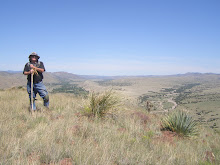Ft. Bayard Days & Apacheria




Ft. Bayard Days was advertised as a Day when Buffalo Soldiers and Warm Springs Apaches would "get together," for the first time, and share. There was initially a promise of "healing and sharing." Some of the Apaches @ the gathering were essentially "open" to this prospect, but in fact, other Apaches that I heard and spoke with were not at all up for such a discussion.
In my own experience with the Vietnam War, I can say that healing in my case, and in many others cases, came only after years of dealing with the horrors of war. In actuality, we do not know much about what happened to the Apaches if they were captured, by Buffalo Soldiers. I know that when some Warm Springs Apaches and others, were captured, I believe, after the 1873 "break out" from San Carlos, they were marched to Ft. Apache roughly and rudely. They complained about being thrown into a guard house or stockade, and having food thrown into them, as "if we were animals."
As I reviewed my own fairly extensive readings of actual military records, details about the treatment of captured Apaches is rarely ever discussed. I can clearly state that over and over again, Apache rancheria were attacked in all kinds of weather. I know for a fact that the military has reported attacking rancheria in the dead of winter; killing men, women and children, and certainly, destroying the rancheria and all items of interest, after the Apache fled the area.
Most Americans and most readers of Apache history may not know that the Apache, at various agencies, were given commodities, and also, were given many utility items, such as:
hatchets; axes; hammers; skillets; pots; pans; cups; rope; medicines; blankets; canvas; belts; trousers; shirts; cooking utensils; salt; sugar; coffee; tobacco; and other items.
Many of these items were modified into instruments that were valuable to the Apache in their modified form. I'm not one to use a metal detector, but since becoming aware of these disbursements, I've wondered: if those metal objects were indeed at rancheria, is the metal scattered and buried at those sites? I know of one, where there may be such metal scattered everywhere, as well as crockery (cups; plates).
Such materials may or may not have been given to Apaches. It may have come from miners or ranchers or some other groups, who camped for a time in those locations.
The point is: when the Army attacked the Apaches at many rancheria, their entire point was to not only capture or kill Apaches, but to also make it even more difficult to survive, say, in the winter, or in dry, unproductive country; or, in country heavily touched by drought. In other words, the Army, in many instances, could have cared less if the Apache, on the run, found their "caches"of such goods, and eked out a living. There was no concern that starvation, freezing in winter, not eating properly in the rest of the year, would result in rancheria destruction.
"War is hell," Sherman actually said. But, one thing I hope to learn from associations with Warm Springs Apaches is: what are YOUR stories of hardship associated with the relentless Army attacks, including those of Buffalo Soldiers, on your people? What measures were passed down to you of how the Buffalo Soldiers treated your relatives?
Until these stories are told, there simply may not be much authentic chance of reconciliation between Apaches and Buffalo Soldiers. We need to learn these stories -- oral -- that the Warm Springs Apaches could possibly tell us. Until we know these stories, it may be wishful thinking that we have a ceremony of "healing and forgiveness." I know, for a fact, that various Apaches at the Ft. Bayard Days event were upset that these words, and these views, were not their words, especially.
In the future, I hope more can be done to actually bring about reconciliation. Hopefully, there are some Buffalo Soldiers who wear the uniforms today, who had relatives in the Apache Wars, who could tell the truth about what they did with the Apaches. Having been a combat infantry veteran, fighting Vietnamese Viet Cong and North Vietnamese, I was, myself, shocked at the depth of racial hatred many American soldiers had for these Asian fighters. And I know that if they had been allowed to mal treat the prisoner s of those Vietnamese groups, they would have relished the chance.
This is a very undertold story, and I hope Warm Springs descendants will honor me by telling these stories.
The photos included here include two, from a possible rancheria in the Florida Mountains.
The other three include photos taken from the general area near Dr. Michael Steck's Southern Apache Agency, about 1000 yards north of Ft. Thorn, along the Rio Grande, near present day Hatch, NM.
Labels: Chihene Apache; Buffalo Soldiers



2 Comments:
How do you keep a people down? You 'never' let them 'know' their history.
The 7th Cavalry got their butts in a sling again after Little Big Horn, fourteen years later, the day after the Wounded Knee Massacre. If it wasn't for the 9th Cavalry Buffalo Soldiers, there would of been a second massacre of the 7th Cavalry. Read, and visit site/great history, rescueatpineridge.com
God, what a bunch of biased b.s.Go back and read the reports that were written during those times. Of course rancherias were attacked.The apache would sweep through the countryside killing men, women and children.And please Jerry, tell the complete story, The army's orders were to kill the braves, and the Women, if the Women attacked them. (many Apache Wonen were combatents).In MOST cases, the Women and children were spared.This was NOT true of the Apache...
Post a Comment
Subscribe to Post Comments [Atom]
<< Home